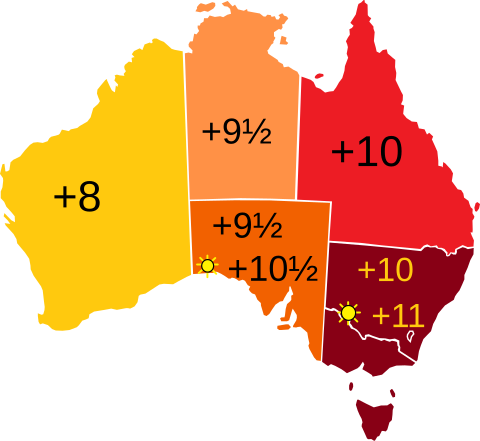Australia Current Time & Time Zone Map & Time Zone
Live time zones for all Australian states and territories

Australian Western Time
UTC+08:00 (AWST, year round)
07:42:00
Monday, October 20, 2025
Example city: Perth
Northern Territory Time
UTC+09:30 (ACST, year round)
09:12:00
Monday, October 20, 2025
Example city: Darwin
Australian South Time
UTC+10:30 (ACDT)
10:12:00
Monday, October 20, 2025
Example city: Adelaide
Queensland Time
UTC+10:00 (AEST, year round)
09:42:00
Monday, October 20, 2025
Example city: Brisbane
New South Wales Time
UTC+11:00 (AEDT)
10:42:00
Monday, October 20, 2025
Example city: Sydney
1. How Many Time Zones Does Australia Have?
Australia spans 5 standard offsets: UTC+08:00 (AWST), UTC+09:30 (ACST), UTC+10:00 (AEST) plus UTC+09:45 (ACWST, unofficial in WA) and UTC+08:45 used locally in a small WA/SA region.
2. Australia Time Zones (Map Reference)
Australian Western Standard Time (AWST)
Standard: UTC+08:00 — Australian Western (year‑round).
Australian Central Standard/Daylight Time (ACST/ACDT)
Standard: UTC+09:30; DST: UTC+10:30 — Australian South and Broken Hill, NSW. Northern Territory remains on ACST year‑round.
Australian Eastern Standard/Daylight Time (AEST/AEDT)
Standard: UTC+10:00; DST: UTC+11:00 — New South Wales (except Broken Hill), Victoria, Tasmania, ACT. Queensland stays on AEST year‑round.
3. Daylight Saving Time schedule (Australia)
Begins on the first Sunday in October at 2:00 a.m. local standard time (clocks move forward to 3:00 a.m.).
Ends on the first Sunday in April at 3:00 a.m. local daylight time (clocks move back to 2:00 a.m.).
Observed by NSW, VIC, TAS, ACT, and SA. QLD, WA, and the NT do not observe DST.
4. History of Australia Time Zones
Australia standardized time zones in the early 20th century. DST usage has varied by state over time; the current pattern has been stable for decades.
5. Learn More About Australia Time Zones
Australia Current Time & Time Zone Map & Time Zone
Live time zones for all Australian states and territories

Australian Western Time
UTC+08:00 (AWST,year round)
07:42:00
Monday, October 20, 2025
Example city: Perth
Northern Territory Time
UTC+09:30 (ACST,year round)
09:12:00
Monday, October 20, 2025
Example city: Darwin
Australian South Time
UTC+09:00 (ACST)
10:12:00
Monday, October 20, 2025
Example city: Adelaide
Queensland Time
UTC+10:00 (AEST,year round)
09:42:00
Monday, October 20, 2025
Example city: Brisbane
New South Wales Time
UTC+11:00 (AEST)
10:42:00
Monday, October 20, 2025
Example city: Sydney
1. How Many Time Zones Does Australia Have?
Australia spans 5 standard offsets: UTC+08:00 (AWST), UTC+09:30 (ACST), UTC+10:00 (AEST) plus UTC+09:45 (ACWST, unofficial in WA) and UTC+08:45 used locally in a small WA/SA region.
2. Australia Time Zones (Map Reference)
Australian Western Standard Time (AWST)
Standard: UTC+08:00 — Australian Western (year‑round).
Australian Central Standard/Daylight Time (ACST/ACDT)
Standard: UTC+09:30; DST: UTC+10:30 — Australian South and Broken Hill, NSW. Northern Territory remains on ACST year‑round.
Australian Eastern Standard/Daylight Time (AEST/AEDT)
Standard: UTC+10:00; DST: UTC+11:00 — New South Wales (except Broken Hill), Victoria, Tasmania, ACT. Queensland stays on AEST year‑round.
3. Daylight Saving Time schedule (Australia)
Begins on the first Sunday in October at 2:00 a.m. local standard time (clocks move forward to 3:00 a.m.).
Ends on the first Sunday in April at 3:00 a.m. local daylight time (clocks move back to 2:00 a.m.).
Observed by NSW, VIC, TAS, ACT, and SA. QLD, WA, and the NT do not observe DST.
4. History of Australia Time Zones
Australia standardized time zones in the early 20th century. DST usage has varied by state over time; the current pattern has been stable for decades.